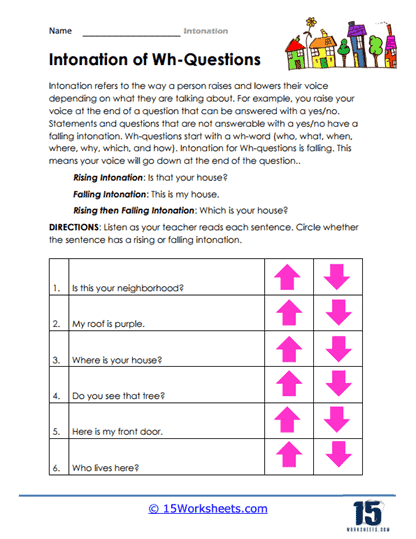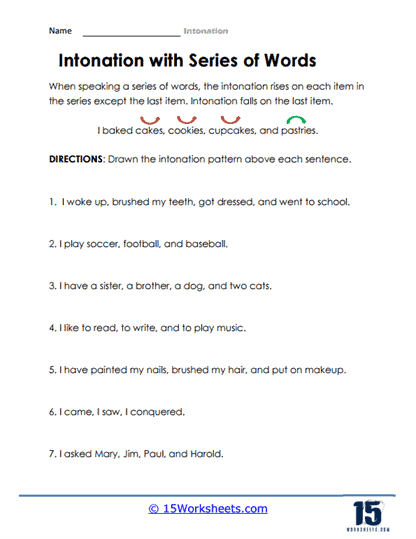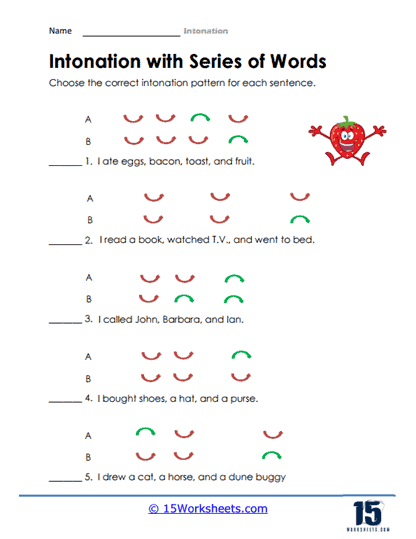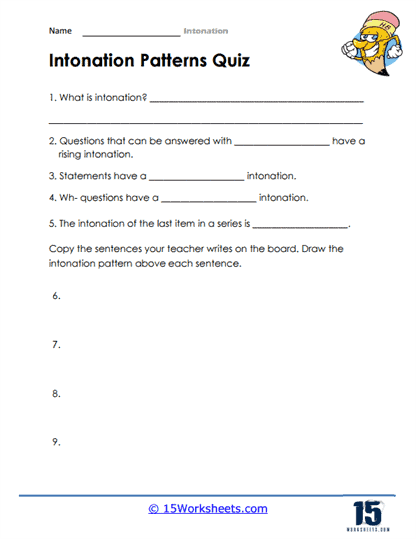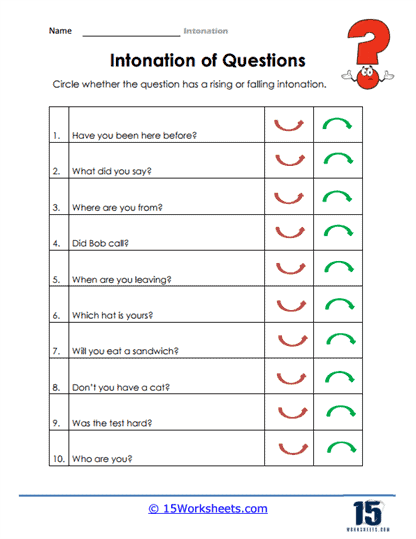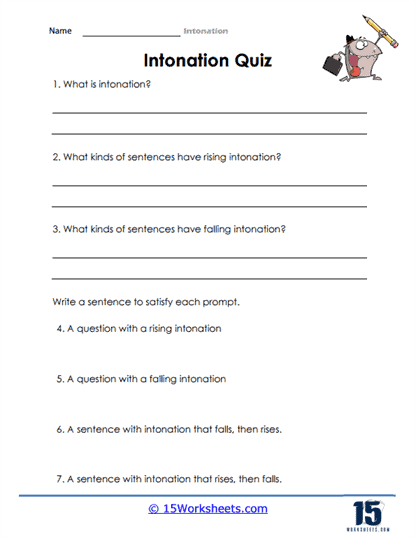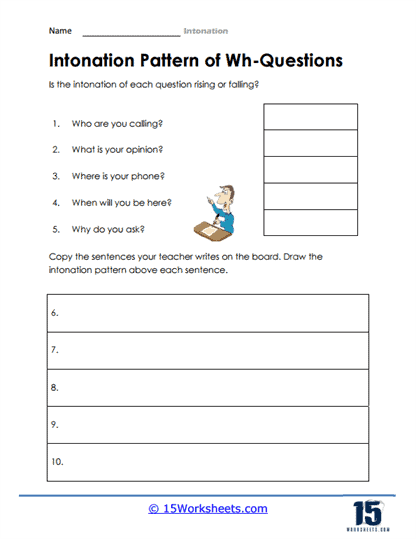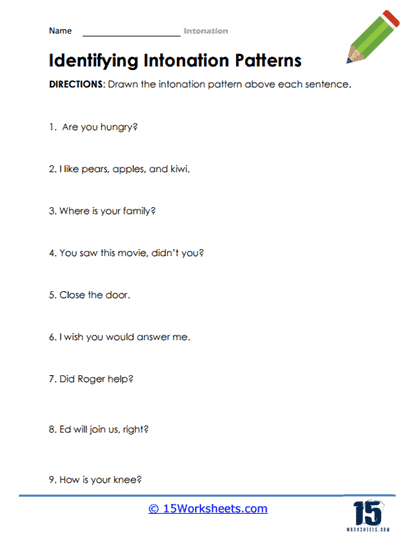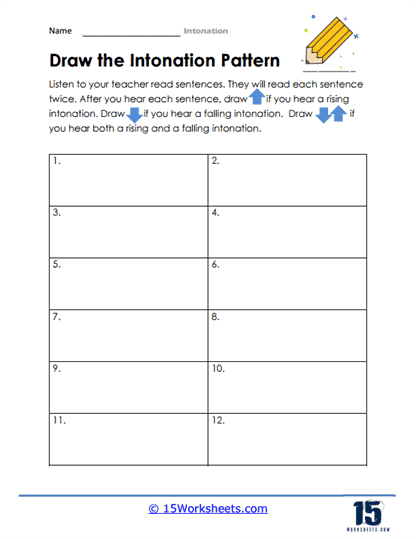Intonation Worksheets
About These 15 Worksheets
Intonation worksheets are educational tools designed to enhance students’ understanding and use of intonation in spoken language. Intonation refers to the variation in pitch when speaking, which can change the meaning of words and sentences. These worksheets aim to develop students’ ability to recognize and produce varying intonations, significantly improving their overall communication skills, language arts, and reading abilities.
Intonation plays a crucial role in conveying emotions, asking questions, making statements, and indicating the mood of the speaker. By practicing with intonation worksheets, students learn to interpret and express subtle nuances in spoken language, leading to more effective and nuanced communication. This skill is invaluable in language arts, as it enhances listening comprehension, speaking fluency, and the ability to engage in expressive reading.
By integrating these worksheets into their study routines, students can significantly enhance their understanding and use of language, benefiting their communication skills, reading comprehension, and overall engagement with language arts. Through the systematic practice of intonation, students not only become more effective communicators but also develop a deeper appreciation for the nuances of language and its impact on interpersonal connections.
There are several types of exercises found on intonation worksheets, each designed to target specific aspects of intonation learning:
Listening and Identifying – These exercises involve listening to audio recordings of sentences spoken with different intonations. Students must identify the type of intonation used (e.g., rising, falling, fall-rise) and what emotion or intention it conveys. This helps students develop a keen ear for intonation patterns and understand their effects on meaning.
Matching Exercises – Students are given sentences alongside a list of emotions or intentions (e.g., happy, questioning, surprised). They must match each sentence to the emotion or intention that best describes the speaker’s likely intonation. This encourages students to think critically about how intonation affects meaning.
Reading and Marking Intonation – In these exercises, students read sentences and mark the intonation they believe should be used, often with arrows going up or down to indicate rising or falling intonation. This practice helps students connect intonation patterns with their corresponding emotions or grammatical functions.
Role-Playing and Speaking – These interactive exercises require students to practice speaking with appropriate intonation. They may work in pairs or groups, taking turns reading dialogues or sentences with specified emotions or intentions. This direct practice reinforces their understanding of intonation and improves their spoken language skills.
Creating Sentences with Intonation Cues – Students are tasked with creating their sentences based on given emotions, intentions, or situations, using appropriate intonation. This exercise promotes creativity and allows students to apply their knowledge of intonation in a practical context.
Intonation Variation Exercises – Here, students are given a single sentence to read in multiple ways, altering the intonation to reflect different emotions or situations. This highlights the versatility of intonation and its impact on the interpretation of sentences.
The Benefits Of These Worksheets
Enhanced Listening Skills – By identifying different intonations, students become more attentive listeners. This attentiveness aids in better understanding spoken language and improves their ability to follow and engage in conversations.
Improved Speaking Fluency – Learning about intonation patterns helps students speak more naturally and expressively. This fluency is essential for effective communication, public speaking, and performances in language arts.
Reading Comprehension and Expression – Understanding intonation enhances students’ ability to comprehend and interpret the emotional or situational context of texts they read. Moreover, it enables them to read aloud more expressively, bringing texts to life and improving their engagement with literature.
Cultural and Linguistic Awareness – Since intonation patterns can vary across languages and cultures, working with intonation worksheets can foster an appreciation for linguistic diversity and the subtleties of language use in different contexts.
Social and Emotional Learning – Recognizing and using intonation appropriately can improve students’ social interactions by helping them convey and interpret emotions more accurately. This emotional intelligence is crucial for personal and academic success.
What is the Literary Device of Intonation?
The literary device of intonation refers to the way authors convey the tone, emotion, or attitude in their writing through the strategic use of word choice, sentence structure, punctuation, and other linguistic elements. Unlike in spoken language, where intonation is expressed through variations in pitch, in literature, it is crafted through text to guide the reader’s perception and interpretation of the narrative. Intonation in literature is pivotal for adding depth, enhancing emotional resonance, and enriching the reader’s experience.
The main defining feature of intonation in literature is its ability to imply the speaker’s or narrator’s attitude towards the subject matter without explicitly stating it. This is achieved through subtle cues in the text that suggest how a line should be “heard” in the reader’s mind, influencing their emotional and intellectual engagement with the story. Intonation can suggest irony, sarcasm, enthusiasm, sadness, and a myriad of other sentiments and stances, often relying heavily on the context and the reader’s familiarity with language nuances to be fully appreciated.
Characteristics of Intonation
Use of Punctuation – Strategic use of exclamation marks, ellipses, question marks, and dashes can suggest pauses, excitement, confusion, or interruptions, respectively, contributing to the perceived intonation.
Word Choice and Order – Specific words carry emotional weight or connotations that influence how a sentence is “heard.” The order of words can also affect the rhythm and emphasis, further contributing to the intended intonation.
Syntax and Sentence Structure – The complexity or simplicity of sentences, the use of fragments, and the arrangement of clauses can all affect the flow and energy of the text, subtly influencing its intonation.
Contextual Clues – The surrounding text and the broader context of the narrative provide key information for interpreting the intonation, including the characters’ emotions, relationships, and the overall mood of the scene.
Examples of Intonation in Literature
Jane Austen’s “Pride and Prejudice” – The famous opening line, “It is a truth universally acknowledged, that a single man in possession of a good fortune, must be in want of a wife,” uses irony as its intonation. Austen’s choice of words, combined with the context of the novel’s exploration of marriage and social expectations, suggests a tongue-in-cheek criticism of the societal assumption that wealthy men are automatically in search of wives. This intonation sets the tone for the novel’s satirical examination of class and marriage.
Edgar Allan Poe’s “The Tell-Tale Heart” – Poe’s use of short, choppy sentences and exclamation points in the narrator’s monologue creates a frantic, paranoid intonation. This reflects the narrator’s unstable mental state and heightens the suspense and intensity of the story. For example, the repetition and emphasis on certain phrases, like “I heard many things in hell,” guide the reader to “hear” the narrator’s growing desperation and guilt, effectively conveying the horror and tension of the narrative.
J.D. Salinger’s “The Catcher in the Rye” – The protagonist, Holden Caulfield’s, use of casual language, contractions, and colloquialisms such as “It killed me” or “phony” create a conversational and cynical intonation. This reflects Holden’s disillusionment with the adult world and his struggle to preserve innocence. Salinger’s careful crafting of Holden’s voice invites readers to connect with the protagonist’s perspective and emotions, making the narrative more engaging and relatable.
The effect of intonation on the reader is multifaceted. It:
Shapes Interpretation – Intonation guides the reader’s understanding of the text, influencing how dialogue is interpreted and how characters and situations are perceived.
Enhances Emotional Engagement – By suggesting the emotional undertones of a narrative, intonation deepens the reader’s emotional connection to the story and its characters.
Conveys Subtext – Intonation allows authors to convey attitudes, criticisms, or themes subtly, adding layers of meaning without explicit exposition.
Sets the Tone – The overall intonation of a piece can establish the mood and atmosphere, affecting the reader’s experience and expectations of the narrative.





